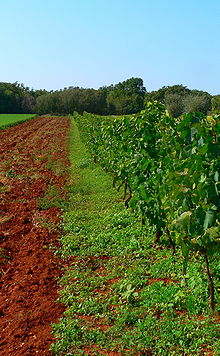
Terra rossa (Italian for 'red soil') is a well-drained, reddish, clayey to silty soil with neutral pH conditions and is typical of the Mediterranean region. The reddish color of terra rossa is the result of the preferential formation of hematite over goethite. This soil type typically occurs as a discontinuous layer that ranges from a few centimeters to several meters in thickness that covers limestone and dolomite bedrock in karst regions. The high internal drainage and neutral pH conditions of terra rossa are a result of the karstic nature of the underlying limestone and dolomite.[1][2][3] Terra rossa is also found associated with Mediterranean climates and karst elsewhere in the world.[4]
Compared to most clay rich soils, terra rossa has surprisingly good drainage characteristics.[1] This makes it a popular soil type for wine production. Among other wine regions, it is found in La Mancha in Spain and the Coonawarra, Fleurieu, Wrattonbully and Barossa Valley growing areas in Australia.[5]
- ^ a b Torrent, J., 2005. Mediterranean soils. In: Hillel, D. (Ed.), Encyclopaedia of Soils in the Environment, vol. 2. Elsevier Academic Press, Oxford, pp. 418–427.
- ^ Merino, E., Banerjee, A. and Dworkin, S., 2006. Dust, terra rossa, replacement, and karst: serendipitous geodynamics in the critical zone. Geochimica et Cosmochimica Acta, 70(18), p. A416.
- ^ Vingiani, S., Di Iorio, E., Colombo, C. and Terribile, F., 2018. Integrated study of Red Mediterranean soils from Southern Italy. Catena.
- ^ Muhs, D.R. and Budahn, J.R., 2009. Geochemical evidence for African dust and volcanic ash inputs to terra rossa soils on carbonate reef terraces, northern Jamaica, West Indies. Quaternary International, 196(1-2), pp. 13-35.
- ^ Huggett, J.M., 2006. Geology and wine: a review. Proceedings of the Geologists' Association, 117(2), pp. 239-247.